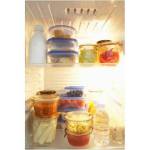Currently, the rush of everyday life means that we use more and more processed, ready-to-eat foods and less and less fresh, natural foods.
 To try to overcome this situation, one of the healthiest options is the freezing of food. The advantage of freezing is that it improves the preservation of food and preparations (which last longer when compared to food preserved in refrigeration). Furthermore, it is possible to plan your meals for the week, always having homemade and much healthier food on hand, saving time and money.
To try to overcome this situation, one of the healthiest options is the freezing of food. The advantage of freezing is that it improves the preservation of food and preparations (which last longer when compared to food preserved in refrigeration). Furthermore, it is possible to plan your meals for the week, always having homemade and much healthier food on hand, saving time and money.
Freezing steps
- Separate good quality and clean food;

- Carry out the necessary procedures for each type of food (see Table 1);
- Place in suitable packaging such as plastic, glass pots or plastic bags suitable for food, in small quantities, ideal for consuming a meal, trying to remove the air, if possible with a specific pump;
- Identify with a label containing manufacturing date and expiration date;
- Place in the freezer at the appropriate temperature, below 18º C;
- Store frozen food at a temperature of -18ºC for up to 3 months;
Never refreeze food.
Table 1. Procedures required for freezing food.
| Foods | Procedures required for freezing |
| Fruits | They must be cleaned and the lumps must be removed. |
| Vegetables | *Bleaching, which better preserves characteristics such as flavor, color, texture, and also causes a reduction in the proliferation of bacteria. |
| Meat | Meat, as well as poultry and fish, must be cleaned and inedible parts (such as excess fat) must be removed. |
| Pre-prepared foods | Prepare food with little seasoning and do not overheat, as the food will be heated again. After preparing the food, place it in suitable packaging, and then place the finished food packaging on a container with cold water and ice. Then, place the food in the refrigerator and after cooling, place it in the freezer. |
*Bleaching refers to the correct washing of vegetables, where damaged parts must be separated. Then, submerge the vegetables in 2.5 liters of boiling water for the time indicated in Table 2.
Cool the vegetables in the same amount of time as they were blanched. First rinse the vegetables under cold running water and then immerse them in ice water. Dry well, package and label.
Table 2. Time required for blanching vegetables
| Vegetables | Time |
| Pumpkin cut into pieces, chard in leaves and stalks, endive, carrot slices, chayote, cauliflower (bouquets only), fresh peas in grains, corn in grains, peppers, whole okra, cabbage | 2 to 3 min |
| Eggplant and broccoli (soak for 30 minutes, blanch in salted water) | 3 to 4 minutes |
| Whole carrot, cassava | 5 min |
| Beetroot, cassava, corn on the cob | 8 min |
Foods that should not be frozen
Eggs in shell, mayonnaise, whipped cream, yogurt, banana, pears, leafy vegetables, puddings in general, tomatoes, potatoes, cucumbers, celery, cream, creamy cheeses, pasta without sauce, thickened creams.
Defrosting
Food must always be defrosted by placing the food in the refrigerator or microwave oven under suitable packaging.
Source:- CyberDiet – http://cyberdiet.terra.com.br/como-congelar-os-alimentos-corretamente-2-1-1-60.html
site Cookbook – http://www.livrodereceitas.com/diversos/congelamento/

